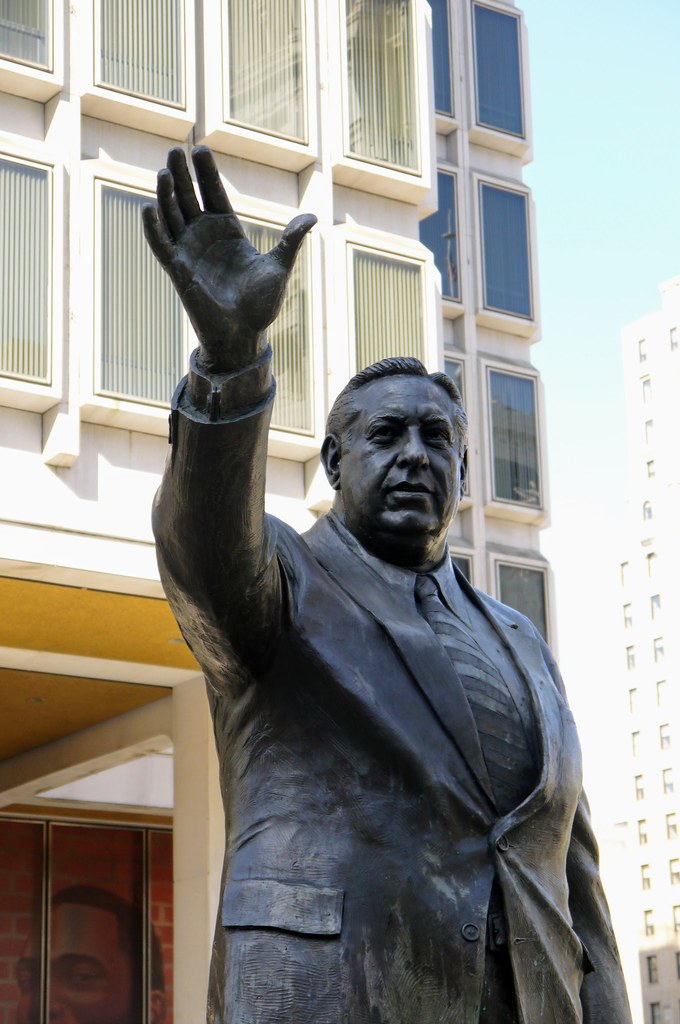Key Takeaways:
• Philadelphia agreed to return a bronze statue of Frank Rizzo to its original commissioners.
• The statue stood in front of the Municipal Services Building from 1998 to 2020.
• Supporters call the return a victory over a “woke mayor.”
• The move highlights ongoing culture wars over public monuments.
• Historians see Rizzo’s populism as an early form of today’s identity politics.
Frank Rizzo Statue Heads Back to Its Commissioning Group
In August 2025, Philadelphia officials signed an agreement to hand over the 2,000-pound bronze statue of Frank Rizzo to the group that paid for it in 1992. The statue once sat outside the Municipal Services Building from 1998 until Mayor Jim Kenney removed it in 2020. Kenney acted after protesters tried to topple the statue following George Floyd’s murder. Now the statue leaves city hands, though it cannot go back on public display.
Background of the Statue
Supporters commissioned the statue to honor Frank Rizzo’s time as police commissioner and mayor. He served as police chief from 1967 to 1971 and led Philadelphia as mayor from 1972 to 1979. As a tribute, artists captured his stern gaze and delivered a 2,000-pound figure in bronze. Its removal sparked debate over who controls public memory and which figures deserve monuments.
Frank Rizzo: From Cop to Mayor
Frank Rizzo grew up in South Philadelphia’s Italian-American neighborhood. He dropped out of high school to join the police force like his father. He earned praise for a clean image and for tough policing in West Philadelphia. In 1964, he led police against crowds after a brutal arrest sparked three days of unrest. He also broke up school integration protests and raided Black Panther offices in 1970.
Why Supporters Celebrate the Return
Supporters view the statue’s return as a win against what they call a “woke mayor.” They argue it honors a leader who stood for law and order. They also see the move as a pushback against modern critics who label Rizzo a racist. For them, the statue symbolizes pride in blue-collar roots and defiance of liberal policies.
Culture Wars Over Monuments
Across the country, communities debate which statues belong in public parks. Some towns remove figures linked to racism or colonialism. Others fight to keep them. Philadelphia’s deal shows that even removed monuments can return to private hands. Yet the agreement bans public display, keeping city leaders from facing new protests.
Frank Rizzo’s Populist Appeal and Today’s Politics
Historians say Frank Rizzo was an early identity-based populist. He urged white, working-class voters to back him against liberal programs. For example, he paused a public housing project in his home neighborhood. He also told supporters to “vote white” for a charter change. In today’s politics, similar appeals echo in national debates over culture and identity.
Comparisons to Modern Populism
Many compare Rizzo to recent politicians who blend social and cultural claims. For instance, some leaders promise to stop “woke” ideas but deliver little on economic fairness. They win by staking a claim on traditional values. Just as Rizzo played to fears of urban decline, modern figures appeal to identity over material change.
Redistributive vs. Identity Populism
Not all populism focuses on identity. Some groups push for redistributive policies that shift resources from elites to workers. In Philadelphia, the Working Families Party won seats by championing affordable housing and fair wages. Yet identity-driven politics still holds strong, as shown by the Rizzo statue fight. The two strands often clash in city councils and election campaigns.
Legal Limits on the Statue’s Future
Under the 2025 agreement, the statue cannot return to any public space in Philadelphia. It must stay on private property away from open view. Supporters can display it in a museum or private park. However, any public unveiling could face legal challenges or community protests. This limit aims to keep the peace while respecting private property rights.
What the Return Says About Memory
The statue’s fate shows how memory shifts with each generation. A figure once honored can become a symbol of injustice. Then, supporters can reclaim it as proof of a lost ideal. By returning it to private hands, Philadelphia tries to balance heritage and progress. Yet the debate over Frank Rizzo’s legacy will likely continue.
Looking Ahead: Monuments and Memory
Cities across America will keep wrestling with their pasts. Some may follow Philadelphia’s path and move statues into warehouses or private collections. Others will leave them up or replace them with new memorials. Either way, the culture wars over monuments reflect deeper divides over identity, power, and history.
FAQs
Why did Philadelphia return the statue to private supporters?
The city settled a legal dispute by giving the statue back to the group that paid for it. They agreed the statue cannot go on public land again.
Can the statue ever be placed in a public park?
No. The agreement bars any public display in Philadelphia. It must stay on private property or in a nonpublic venue.
How did Frank Rizzo shape Philadelphia politics?
He rose from police chief to mayor by promising law and order. He championed white, working-class voters and resisted liberal reforms.
Will this deal settle the debate over Rizzo’s statue?
Not likely. While the statue leaves city hands, debates over his legacy and the role of monuments will carry on.

